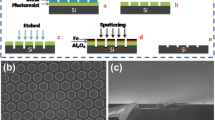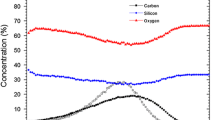Abstract
The principal interests in this work are energetic-beam control of carbon-film properties and the roles of doping and surface morphology in field emission. Carbon films with variable sp3-bonding fraction were deposited on n-type Si substrates by ArF (193 nm) pulsed-laser ablation (PLA) of a pyrolytic graphite target, and by direct metal ion beam deposition (DMIBD) using a primary Cs+ beam to generate the secondary C- deposition beam. The PLA films are undoped while the DMIBD films are doped with Cs. The kinetic energy (KE) of the incident C atoms/ions was controlled and varied over the range from ∼25 eV to ∼175 eV. Earlier studies have shown that C films’ sp3-bonding fraction and diamond-like properties can be maximized by using KE values near 90 eV. The films’ surface morphology, sp3-bonding fraction, and Cs-content were determined as a function of KE using atomic force microscopy, TEM/EELS, Rutherford backscattering and nuclear reaction measurements, respectively. Field emission (FE) from these very smooth undoped and Cs-containing films is compared with the FE from two types of deliberately nanostructured carbon films, namely hot-filament chemical vapor deposition (HF-CVD) carbon and carbon nanotubes grown by plasma-enhanced CVD. Electron field emission (FE) characteristics were measured using ∼25-μm, ∼5-μm and ∼1-μm diameter probes that were scanned with ∼75 nm resolution in the x-, y-, and z-directions in a vacuum chamber (∼5 × 10-7 torr base pressure) equipped with a video camera for viewing. The hydrogen-free and very smooth a-D or a-C films (with high or low sp3 content, and with or without ∼1% Cs doping) produced by PLD and DMIBD are not good field emitters. Conditioning accompanied by arcing was required to obtain emission, so that their subsequent FE is characteristic of the arc-produced damage site. However, deliberate surface texturing can eliminate the need for conditioning, apparently by geometrical enhancement of the local electric field. But the most promising approach for producing macroscopically flat FE cathodes is to use materials that are highly nanostructured, either by the deposition process (e.g. HF-CVD carbon) or intrinsically (e.g. carbon nanotubes). HF-CVD films were found to combine a number of desirable properties for FE displays and vacuum microelectronics, including the absence of conditioning, low turn-on fields, high emission site density, and apparent stability and durability during limited long-term testing. Preliminary FE measurements revealed that vertically aligned carbon nanotubes are equally promising.
Similar content being viewed by others
References
See for example J. H. Jung, B. K. Ju, Y. H. Lee, J. Jang, and M. H. Oh, IEEE Elec. Dev. Lett. 18, 197 (1999).
See for example A. A. G. Driskill-Smith, D. G. Hasko, and H. Ahmed, Appi. Phys. Lett. 75, (1999).
C. A. Spindt, I. Brodie, L. Humphrey, and E. R. Westerberg, J. Appl. Phys. 47, 5248 (1976).
F. J. Himpsel, J. A. Knapp, J. A. Van Vechten, and D. E. Eastman, Phys. Rev. B 20, 624 (1979).
J. Van der Weide, and R. J. Nemanich, Appl. Phys. Left. 62, 1878 (1993).
W. A. de Heer, A. Chatelain, and D. Ugarte, Science 270, 1179 (1995).
D. Zhou, A. R. Krauss, T. D. Corrigan, T. G. McCauley, R. P. H. Chang, and D. M. Gruen, J. Electrochem. Soc. 144, 224 (1997).
W. Zhu, G. P. Kochanski, and S. Jin, Science 282, 1471 (1998).
B. F. Coll, J. E. Jaskie, J. L. Markham, E. P. Menu, A. A. Talin, and P. von Allmen, in Covalently-Bonded Disordered Thin-Film Materials, ed. by M. P. Siegal, W. Milne, and J. E. Jaskie, Materials Research Society, Warrendale, PA, 1998.
V. I. Merkulov, D. H. Lowndes, and L. R. Baylor, Appl. Phys. Lett. 75, 1228 (1999).
J. Robertson, J. Vac. Sci. Technol. B 17, 659 (1999).
F. Y. Chuang, C. Y. Sun, T. T. Chen, and I. N. Lin, Appl. Phys. Lett. 69, 3504 (1996).
O. Groning, O. M. Kuttel, P. Groning, and L. Schlapbach, Appl. Surf Sci. 111, 135 (1997).
A. V. Karabutov, V. I. Konov, V. G. Ralchenko, E. D. Obraztsova, V. D. Frolov, S. A. Uglov, H.-J. Scheibe, V. E. Strelnitskij, and V. I. Polyakov, Diamond and Related Mater. 7, 802 (1998).
C. Park, H. Park, Y.-K. Hong J. S. Kim, and J. K. Kim, Appl. Surf Sci. 111, 140 (1997).
J. H. Jung, B. K. Ju, Y. H. Lee, J. Jang, and M. f-t. Oh, IEEE Elec. Dev. Lett. 18, 197 (1997).
V. G. Litovchenko, A. A. Evtukh, R. I. Marchenko, N. I. Klyui, and V. A. Semenovich, Appl. Surf Sci. 111, 213 (1997).
N. S. Xu, J. C. She, S. E. Huq, J. Chen, and S. Z. Deng, Appl. Phys. Lett. 73, 3668 (1998).
J. C. She, S. E. Huq, J. Chen, S. Z. Deng, and N. S. Xu, J. Vac. Sci. Technol. B 17, 592 (1999).
Y. Park, Y. W. Ko, M. H. Sohn, and S. I. Kim, Mater. Res. Soc. Symp. Proc. 396, 623 (1996).
S. I. Kim, Rev. Sci. Instr. 67, 908 (1996).
M. H. Sohn, Y. O. Ahn, Y. W. Ko, S. R. Hah, T. E. Fischer, and S. I. Kim, J. Vac. Sci Technol. A 16, 3554 (1998).
Y. W. Ko and S. I. Kim, J. Vac. Sci. Technol. A 15, 2750 (1997).
S. P. Bozeman, S. M. Camphausen, J. J. Cuomo, S. I. Kim, Y. O. Ahn, and Y. Ko, J. Vac. Sci. Technol. A 15, 1729 (1997).
V. 1. Merkulov, D. H. Lowndes, Y. Y. Wei, and G. Eres, “Patterned growth of individual and multiple vertically-aligned carbon nanotubes,” submitted to Applied Physics Letters.
D. H. Lowndes, V. I. Merkulov, A. A. Puretzky, D. B. Geohegan, G. E. Jellison, Jr., X. M. Rouleau, and T. Thundat, Mat. Res. Soc. Symp. Proc. 526, 325 (1998).
D. H. Lowndes, V. I. Merkulov, A. J. Pedraza, J. D. Fowlkes, A. A. Puretzky, D. B. Geohegan, and G. E. Jellison, Jr., Symposium on Surface Engineering: Science and Technology I. Proc. of TMS 1999 Annual Meeting, 1999 (in press).
V. I. Merkulov, D. H. Lowndes, G. E. Jellison, Jr., A. A. Puretzky, and D. B. Geohegan, Appl. Phys. Lett. 73, 2591 (1998).
A. A. Puretzky et al., Appl. Surf Sci. 96-98, 859 (1996).
D. B. Geohegan and A. A. Puretzky, Mat. Res. Soc. Symp. Proc. 397, 55 (1996).
This method of producing a C- beam was developed by SKION Corp. and has been used to produce negative-ion beams of several metals.
R. D. Forrest, A. P. Burden, S. R. P. Silva, L. K. Cheah, and X. Shi, Appl. Phys. Lett. 73, 3784 (1998).
Y. W. Ko and S. I. Kim, J Vac. Sci. Technol. A 15, 2750 (1997).
V. I. Merkulov, D. H. Lowndes, and L. R. Baylor, Appl. Phys. Lett. 75, 1228 (1999).
A. Gohl, A. N. Alimova, T. Habermann, A. L. Mescheryakova, D. Nau, V. V. Zhirnov, and G. Muller, J. Vac. Sci. Technol. B 17, 670 (1999).
V. I. Merkulov, D. H. Lowndes, and L. R. Baylor, “Field emission and nanostructure of carbon films, ” submitted to Amorphous and Nanostructured Carbon, Symposium U of the Fall, 1999 MRS meeting, Boston, MA (in press).
R. H. Fowler and L. W. Nordheim, Proc. Roy. Soc. London, Ser. A 119, 173 (1928).
Further information can be obtained from SKION Corp.
Author information
Authors and Affiliations
Rights and permissions
About this article
Cite this article
Lowndes, D.H., Merkulov, V.I., Baylor, L.R. et al. Field Emission from Carbon Films Deposited by Controlled-Low-Energy Beams and CVD Sources. MRS Online Proceedings Library 585, 271–282 (1999). https://doi.org/10.1557/PROC-585-271
Published:
Issue Date:
DOI: https://doi.org/10.1557/PROC-585-271




